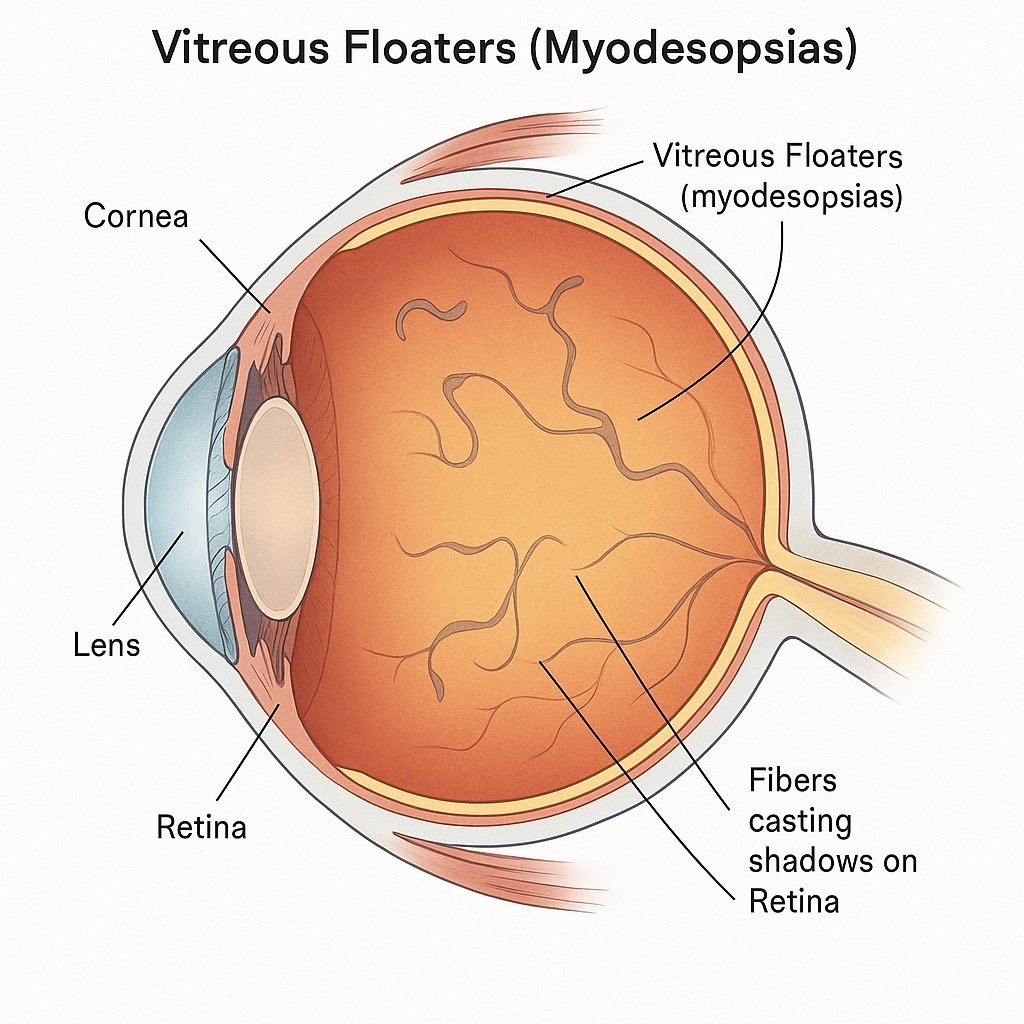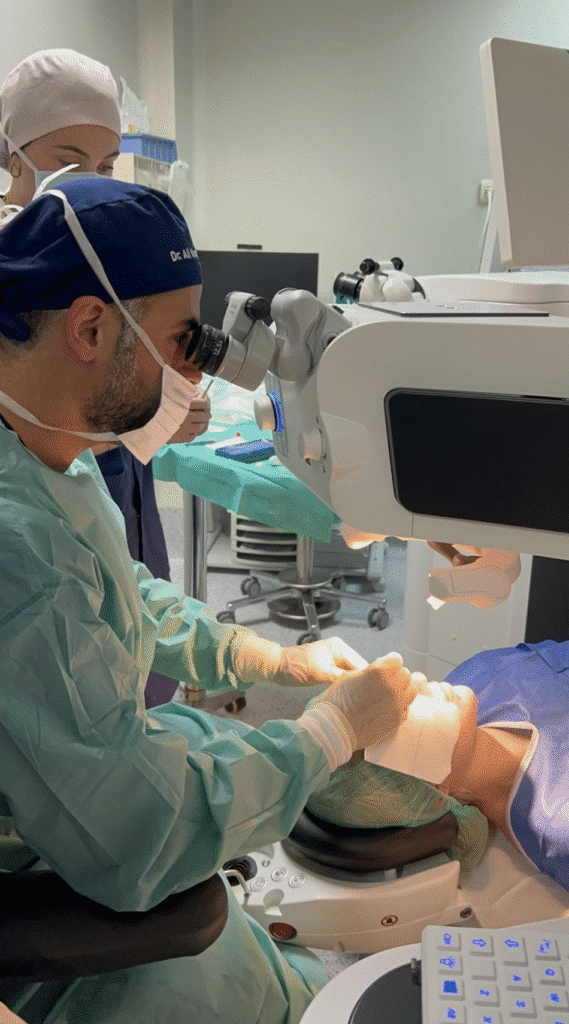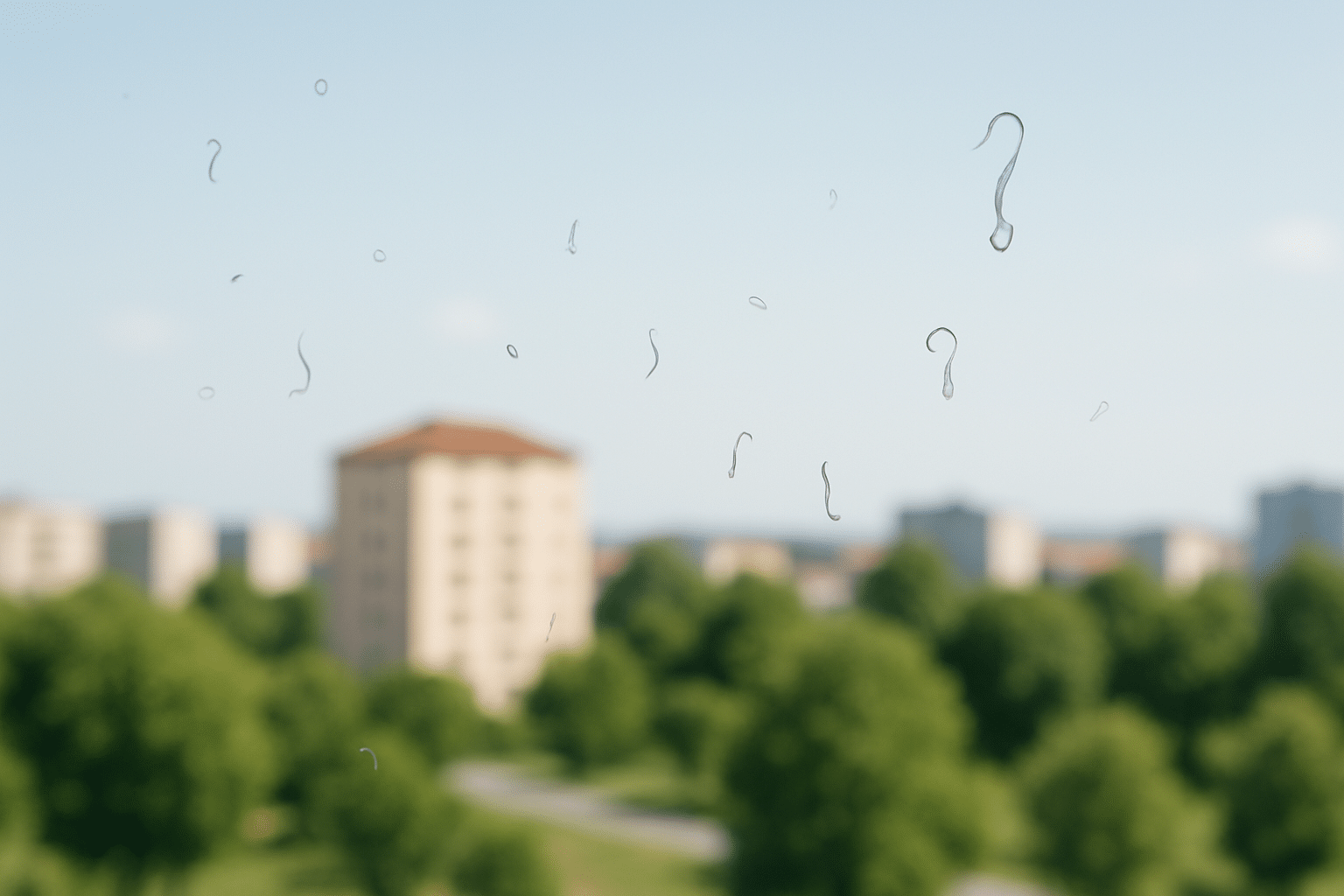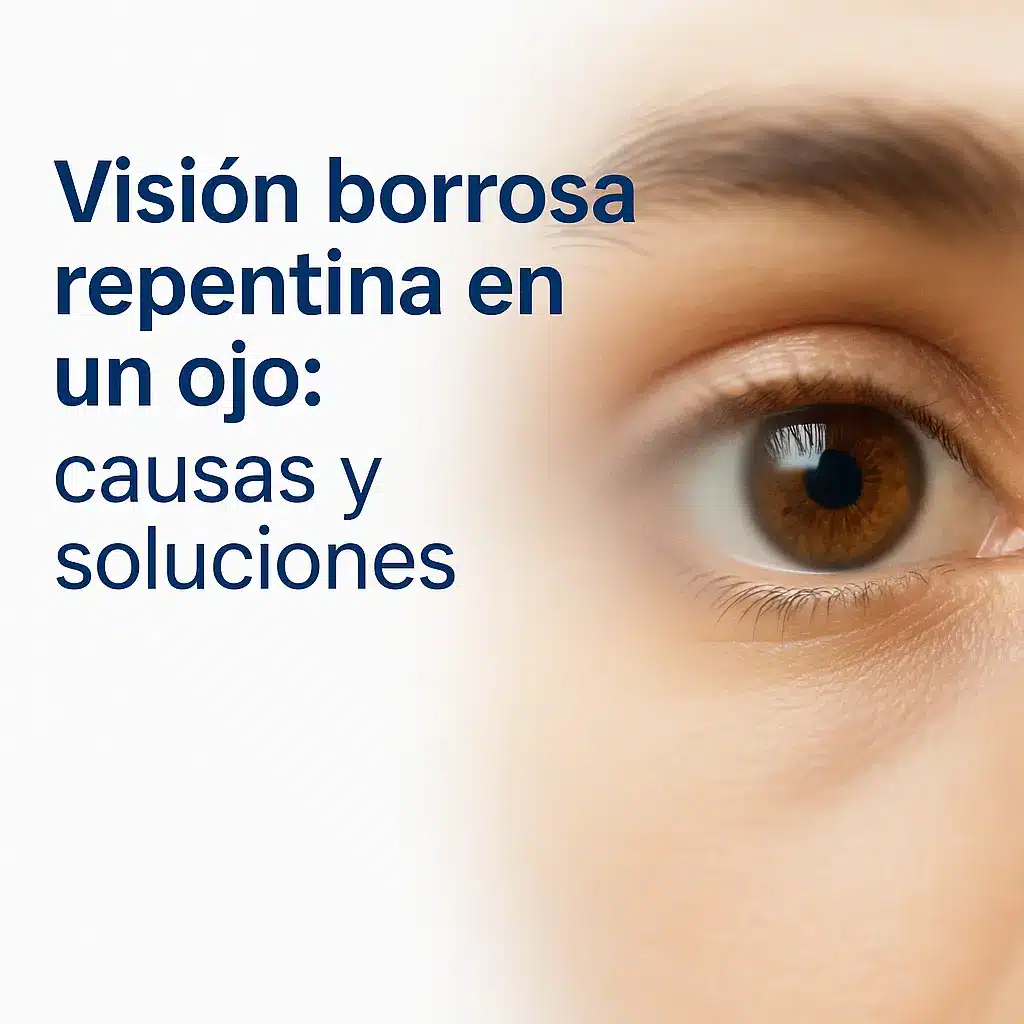The hoverflies are small opacities that appear in the visual field. These shadows are projections of fibres onto the vitreous humour and are common in people, especially as they age. The perception of these flies is often more intense on light backgrounds. Although they are generally not a serious problem, their appearance can cause concern and it is important to understand their causes and symptoms.
What are hoverflies?
Floaters are a visual phenomenon that many people experience throughout their lives, especially as they get older. This section will explore their definition and the reason behind their name.
For more information, you can watch the following video:
Definition of hoverflies
Hoverflies, scientifically known as "hoverflies" or "hoverflies". myodesopsiasvitreous opacities are small opacities found in the vitreous humour, the gel that occupies the inside of the eye. These opacities can take various forms, such as shadows, threads or dark spots. Although they float in the visual field, they are not actually external objects, but shadows that are cast on the retina as the eye moves.
Myodesopsia are particularly visible in bright light, such as when looking at a clear sky or a white surface. This is because bright light highlights the shadows that these opacities cast on the retina. People often notice these floating formations and, although they may be annoying to some, they are commonly considered harmless.
Why are they called hoverflies?
The name 'floaters' comes from the way these opacities are visually perceived. Many people describe their appearance as similar to small flies moving across the field of vision. This metaphor illustrates how disturbing hoverflies can be when they come into focus, especially in situations where the background is light or bright.
The term also reflects the ephemeral nature of these floating bodies. They often escape vision when one attempts to look directly at them, as they tend to move as the eyes move. This creates the sensation that the 'flies' are in constant motion, which contributes to the visual confusion experienced by those who perceive them.

Causes and risk factors
The occurrence of floaters is related to a number of causes and risk factors that can influence eye health. The following are the most relevant conditions that may contribute to their development.
Age-related changes
Age is one of the most important factors in the development of myodesopsia. As people age, their eyes can undergo significant changes.
- Ocular ageing process: Over time, the tissues and structures of the eye undergo natural deterioration. The vitreous, which is the gel that occupies the inside of the eye, changes, which can lead to the formation of opacities. This process is normal, but it becomes more evident from the age of 50.
- Dehydration of the vitreous humour: As part of ageing, the vitreous humour can become dehydrated. This decrease in water not only alters the consistency of the gel, but also allows condensation to form which, when projected onto the retina, creates the perception of floaters. This phenomenon is quite common among the elderly.
Conditions that increase risk
There are certain conditions that may increase the likelihood of developing blowflies. These factors should be considered as additional risk factors.
- Myopia: Myopic individuals tend to have a higher risk of experiencing myodesopsia. The elongated shape of the eye in myopic individuals can cause more rapid and pronounced changes in the vitreous structure, which favours the formation of these floaters. For more information, please see our section on the myopia operation.
- Cataract surgery: Persons who have been subjected to cataract surgery may encounter an increase in the occurrence of floaters. During the procedure, the vitreous may be disrupted, which in turn may affect visual perception post-operatively.
- Eye inflammations and ocular haemorrhages: Inflammatory conditions in the eye, as well as haemorrhages, can contribute to floaters. These problems alter the integrity of the vitreous, facilitating the formation of visible opacities in the field of vision.
Vitreous detachment
Vitreous detachment is one of the most worrying causes of sudden new floaters. This condition occurs when the vitreous separates from the retina, which can lead to alarming symptoms, such as the sudden increase in floaters and flashes of light. Recognising this phenomenon is crucial in order to seek timely medical attention and avoid more serious complications.

Symptoms and Perception of Flying Flies
The perception of hoverflies can vary from person to person. The associated symptoms can be disconcerting, but are generally harmless. The most common features associated with these visual manifestations are described below.
Fly Shapes and Movements
These small opacities can take different forms, which are often described as:
- Dark spots appearing in the visual field.
- Thin filaments that move rhythmically.
- Spider webs that seem to float and move.
Hoverflies may appear especially active when the eye moves. When the eye moves, these floating bodies may give the impression that they are crawling to one side. This behaviour may cause confusion, as they often cannot be seen when attempting to observe them directly.
Increased visibility in different funds
The perception of these flies is much more noticeable at light or illuminated backgrounds. Situations such as looking at a clear sky, a white sheet of paper or a bright screen can intensify their presence. On the other hand, on dark or complex backgrounds, it is more difficult to notice these opacities. This phenomenon is due to how the shadows of hoverflies are cast on the surface of the retina.
Sudden onset and other warning signs
A sudden increase in the number of floaters can be a cause for concern. Such a change, especially if observed in one eye, should be evaluated by a specialist. Some other symptoms that may accompany the appearance of floaters include:
- Flashes of light (photopsias).
- Partial or complete loss of vision.
- Presence of shadows or curtains in the visual field.
These symptoms are indicative of possible complications, such as retinal tears or detachment. It is crucial to attend to any significant changes in vision to avoid serious consequences for eye health.
Diagnosis of Flying Flies
The diagnosis of hoverflies is based on a comprehensive eye assessment. This process involves the use of specific techniques to identify the presence of these opacities and to rule out other eye conditions that may be more serious.
Eye examination techniques
In order to carry out the diagnosis, various techniques are used to allow the specialist to examine the state of health of the eyes properly. These methods are essential to obtain a clear picture of the patient's eye condition. Tests may include:
- Clinical assessment: The doctor will begin with a detailed review of the patient's medical history and symptoms, looking for any history that may indicate eye problems.
- Visual acuity tests: The patient's ability to see clearly is assessed, which helps to determine if the presence of floaters is interfering with their vision.
- Fundus examination: Using an ophthalmoscope, the retina and vitreous are examined to identify any irregularities, such as detachments or tears.
Pupil dilation and imaging tests
A crucial step in the diagnosis is the dilation of the pupilsThis allows for a more thorough examination of the back of the eye and other internal structures. For this dilation, drops are used to relax the muscles of the iris, thus facilitating better visibility of the inside of the eye. Once the pupils are dilated, a number of additional tests can be performed, such as:
- Optical coherence tomography (OCT): This non-invasive imaging technique allows detailed images of the retina and vitreous to be obtained, helping to detect any alterations that may not be visible to the naked eye.
- Ocular ultrasound: In specific cases, ultrasound may be used to assess the status of the vitreous and adjacent structures, especially if detachment is suspected.
Together, these diagnostic methods will allow the ophthalmologist to determine if the floaters are benign or if there is an underlying condition that requires medical attention. Proper follow-up is essential to ensure future eye health.
Treatment of Blowflies
Treatment for hoverflies varies according to the severity of the symptoms and the interference they may cause in the individual's daily life. In many cases, no intervention is required, but there are approaches available for those seeking relief from the condition.
Non-surgical options
People who experience floaters often find relief through non-invasive methods, allowing them to adjust to their situation without the need for surgery.
- Adaptation to hoverflies: One of the most common strategies is adaptation. Over time, many people learn to ignore these opacities, allowing them to reduce their impact on vision. This process may include a redirection of visual attention, avoiding looking directly at the flies, which helps to reduce their appearance in the visual field.
- Practical tips to minimise their impact:
- Wear sunglasses when outdoors, as direct light may increase the visibility of hoverflies.
- Avoid staring at bright or light surfaces, such as white walls or clear skies, which may make flies more noticeable.
- Incorporating visual exercises that promote eye health, such as alternating between near and far objects, can help the brain better adapt to opacities.
YAG laser treatment and vitreolysis for floaters
For patients with floaters that interfere significantly with their quality of life, we offer the YAG laser vitreolysis as a minimally invasive alternative to vitrectomy. This state-of-the-art treatment makes it possible to fragment and vaporise the vitreous opacities responsible for myodesopsia, reducing their size and improving the transparency of the vitreous without incisions or intraocular surgery. The laser vitreolysis is ambulatory, quick and painless, and can offer remarkable relief from the perception of floaters, allowing patients to safely and effectively regain visual comfort under the supervision of an expert such as Ali Nowrouzi.

Surgical options
When symptoms are severe and significantly affect quality of life, surgical alternatives may be considered. However, these are often the last option due to the associated risks.
- Vitrectomy: procedure and risks: The vitrectomy is a surgical procedure in which the vitreous humour is removed from the eye and replaced with a saline solution. This treatment can be effective in eliminating floaters, but it is not without risk. Potential drawbacks include complications such as retinal tear, haemorrhage or infection. Therefore, it is crucial that you are evaluated by a specialist before opting for this type of intervention. The decision on how to proceed must be carefully considered, taking into account the patient's individual circumstances.
Prevention and maintenance of eye health
Eye health is essential to overall wellbeing. Taking certain steps can help maintain vision and reduce the risk of eye problems in the future.
Regular eye health monitoring
Perform regular reviews with an ophthalmology specialist is essential to detect any abnormalities early. During these consultations, changes in vision and conditions that could compromise eye health can be identified, as well as educating the patient on proper eye care.
- It is recommended that persons over 50 years old undergo annual reviews.
- For those with pre-existing conditions or risk factors, screenings should be more frequent.
- Comprehensive vision testing may include fundus evaluation and intraocular pressure measurement.
Medical recommendations to minimise complications
There are several guidelines that can help prevent eye problems and maintain good eye health over time. Implementing healthy habits and following certain recommendations, such as those in the American Academy of Ophthalmologycan make a noticeable difference to eye health.
- The following should be maintained balanced diet rich in vitamins A, C and E, as well as omega-3 fatty acids, which are beneficial for eye health.
- Protect eyes from excessive sun exposure wearing sunglasses that offer UV protection is key to preventing retinal damage.
- Avoid smoking also helps to reduce the risk of developing eye problems such as macular degeneration.
- Limiting screen time and taking regular breaks can prevent eyestrain and other related symptoms.
- The adequate hydration is vital as it helps to maintain eye lubrication and prevent dry eye syndrome.
When to consult a specialist
Identifying when it is necessary to see a specialist is key to preserving eye health. Certain manifestations may be indicative of more serious conditions that require immediate medical attention. If you are experiencing troubling symptoms, don't hesitate to contact our clinic.
Symptoms requiring immediate medical attention
The appearance of symptoms related to floaters may cause concern, and certain signs should be evaluated by an eye care professional without delay:
- Substantial increase in the number of hoverflies: Any abnormal increase in the number of opacities can be a cause for alert.
- Observation of new floating bodies in one or both eyes: The sudden appearance of floaters may indicate a significant change in eye health.
- Flashes of light (photopsias): The perception of lights flashing or appearing in the visual field can be a symptom that should not be ignored.
- Loss of lateral or central vision: The presence of blurred areas or a dark shadow blocking vision can be a sign of serious complications.
Retinal tears and detachment
The tearing or retinal detachment are medical emergencies that threaten vision. A tear occurs when the retina breaks, and a detachment is when the retina separates from its normal position in the eye, which can lead to permanent vision loss if not treated quickly. Symptoms that often accompany these conditions include:
- Sudden appearance of hoverflies: This phenomenon can be intensified in the case of a tear or detachment.
- Flashes of light: These may be especially noticeable during eye movements.
- Curtain or obscuration of vision: A sensation of a shadow covering part of the visual field may be indicative of detachment.
Immediate attention allows specialists to perform sight-saving interventions, such as retinal surgery. Thorough examinations and timely treatment are crucial to address these critical eye problems.












